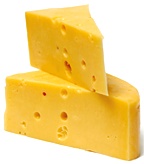The Benefits of Living Foods
By Zhenya K. Wine
When we hear the word "bacteria" in today's sterility-obsessed society, we inevitably associate the word with something bad; something we need to kill. What if I told you that without certain "good" bacteria, your health would be in danger? The good news is these bacteria are easy to come by, and you can create them in foods through the process of fermentation. What Is Fermentation? Fermented foods are pungent in smell and flavor, and are created by healthy bacteria (or culture) eating the sugars in the foods that they ferment. You see fermentation in fruits and vegetables as they overripen and rot, but the type of foods I am talking about are the "probiotic" bacteria (good, live, health-building bacteria) that we can create and control through the careful process of fermentation. Many of the foods we consume daily are fermented or have been made with fermented components - wine, beer, apple cider, vinegar, cheese, cottage cheese, yogurt, buttermilk, bread (yeast), kimchi, soy sauce, miso soup, sauerkraut and pickles, to name a few.
 As an immigrant from Riga, Latvia, formerly part of the USSR, I cannot envision my life without fermented foods. According to the Food and Agriculture Organization of the United Nations, "Fermentation is one of the oldest forms of food preservation technologies in the world. Indigenous fermented foods such as bread, cheese, and wine have been prepared and consumed for thousands of years and are strongly linked to culture and tradition." In fact, the ease of buying fresh sauerkraut, farmer's cheese and pickles in the local market is one of the few things that I miss from my life in Riga. Only after I started my medical training did I realize the importance of fermented foods, and today I go to great lengths to make sure I ingest something that has good bacteria in it every day.
As an immigrant from Riga, Latvia, formerly part of the USSR, I cannot envision my life without fermented foods. According to the Food and Agriculture Organization of the United Nations, "Fermentation is one of the oldest forms of food preservation technologies in the world. Indigenous fermented foods such as bread, cheese, and wine have been prepared and consumed for thousands of years and are strongly linked to culture and tradition." In fact, the ease of buying fresh sauerkraut, farmer's cheese and pickles in the local market is one of the few things that I miss from my life in Riga. Only after I started my medical training did I realize the importance of fermented foods, and today I go to great lengths to make sure I ingest something that has good bacteria in it every day. What Are Probiotic Bacteria? The best way to get your minerals, vitamins and general nutrients is by eating or drinking them, and this is even more true with probiotic bacteria. The most commonly known bacteria that is good for our health is Lactobacillus, which is found in both fermented vegetables and dairy. The two most commonly known species are Lactobacillus brevis, which is found in sauerkraut and pickles, and Lactobacillus acidophilus, which is mostly found in cultured dairy products, such as cheese, yogurt, buttermilk and cultured cottage cheese, among many others. What makes these bacteria probiotic? Their main function is to eat either lactose (a milk sugar) or a sugar found in the vegetable or fruit, and then to convert it into lactic acid and hydrogen peroxide. The presence of lactic acid in the digestive tract prevents other harmful bacteria from living and, thus, we are able to get rid of the organisms that are harmful to our health. The presence of hydrogen peroxide in our blood allows for better oxygenation of the blood, and removes free radicals from our bodies. These bacteria can enhance the function of our immune systems and can even reduce cholesterol. So, how does the fermentation process start, and what is nessessary for home fermentation? According to the Joint Genome Institute, the Leuconostoc mesenteroides bacteria is actually found on fruit and vegetable plants and is responsible for the beginning of fermentation in such products as sauerkraut and pickles. However, as consumers, we need to be aware that not all fermented foods are full of healthy bacteria. The Lactobacillus bacteria do not survive severe amounts of heat or sunlight, so canning or cooking fermented foods will kill this bacteria. The only way to ensure there are live bacteria is to ingest fermented foods that have not been heated or exposed to a great amount of light. When shopping, look for the word "cultured" on the label - you will find it only on foods found in the refrigerated section of the supermarket. Fermented foods are some of the forgotten foods in our Western society, but with the rise in popularity of probiotics, I hope these simple and healthy "old-world" treats will once again reclaim a prominent place in our diet. Do-It-Yourself Home Fermentation It is surprisingly quick and easy to prepare your own fermented foods. To Make Sauerkraut: - Select the heaviest head of green cabbage you can find, with the leaves packed closely together, preferably from the farmer's market.
- Take off all of the outer leaves and the stem and shred the cabbage finely.
- Rinse a large mixing bowl and a gallon jar with boiling water, thus ensuring a "bacteria-free" environment.
- Place the shredded cabbage into the bowl, add a pinch of salt to break down the fibers in the cabbage, and vigorously squeeze the cabbage. When you see the cabbage give juice and you feel the fibers get slightly soggy, place the mixture into the jar and pack tightly.
- Place a weight on top of the cabbage so the leaves are submerged in the cabbage's juice, and cover the top of the jar with a piece of cheesecloth. Leave the jar in a well-ventilated place for three to five days.
The fermentation process will go faster in the summer, but since most homes are climate controlled, it takes three to seven days to ferment in a home at 70 degrees. After the fermentation has begun, you can slow it down by refrigerating the sauerkraut.
 To Make Farmer's Cheese
To Make Farmer's Cheese
(A Dry, Crumbly Type Of Cheese): - In a sterilized, oven-safe, enameled or steel pot, mix equal parts of acidophilus milk and buttermilk.
- If desired, add salt, pepper or herbs for additional flavor.
- Cover with cheesecloth.
- Place on top of the stove and leave for at least 24 hours.
- When the mixture becomes gelatinized, heat the oven to 200 degrees and place the pot in the oven for 1 to 1-½ hours.
- Remove the pot from the oven and cool to room temperature.
- Strain through the cheesecloth by placing several layers of cheesecloth into the colander, and slowly pour the mixture into the cloth.
- After most of the liquid has strained off, tie the ends of the cheesecloth to create a way to let the farmer's cheese drip for at least eight hours.
- Refrigerate for no more than one week.
Zhenya K. Wine has practiced and taught Russian medical and sports massage and physiotherapy for 31 years, and runs the Kurashova Institute in Rock Island, Ill.
Page printed from:
http://www.toyourhealth.com/mpacms/tyh/article.php?id=965&no_paginate=true&no_b=true
|

